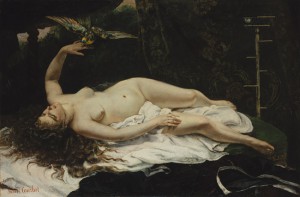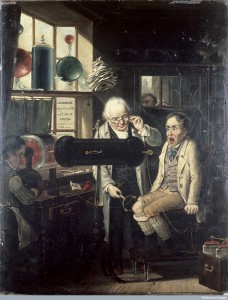I looked at the images before listening to the video. At first I began to look at each picture individually, while reading the text for each one. I was a bit confused with some of them. After I listened to the video, I went back and read all the texts straight through. It was as though a story was being told about the way they were mistreated and thought of as objects, and experiments rather than humans with rights. African Americans were given stereotypes and labels, rather than names and respect. The first and last 2 photos gave expressed the voice of the artist. The series is upsetting which is why the last photo says, “And I cried”. It is upsetting because I myself couldn’t imagine being treated as a label, as an experiment, having taken away my human rights and dignity. Being photographed topless, forced, and feeling uncomfortable is dehumanizing someone. I thought her work was very clever, and it makes everyone understand what was really going on. I myself am not artistic, so when looking at just photographs, it is a little bit more difficult to strip it apart and find its true meaning. When reading the captions, with the photo, it is similar to watching a movie where everything ties in.
Category Archives: Uncategorized
A birth scene. Oil painting by Abo.Sw
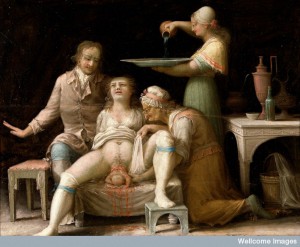
V0017247 A birth-scene. Oil painting by a French (?) painter, Åbo, Sw
Credit: Wellcome Library, London. Wellcome Images
images@wellcome.ac.uk
http://wellcomeimages.org
A birth-scene. Oil painting by a French (?) painter, Åbo, Sweden (later Turku, Finland), 1800.
1800 Published: –
Copyrighted work available under Creative Commons Attribution only licence CC BY 4.0 http://creativecommons.org/licenses/by/4.0/
This image displays a woman giving birth at home. The woman is sitting on a chair to give birth. The basket under the table, the lamp, chair indicates home. She is surrounded by a man who probably is her husband , an elderly woman woman who is playing the role of midwife and a female who appears to be pouring medicine. The male figure supports her back but appears to be scornful at the same time with his right hand flailed. Appears that he intends not to touch the blood or baby until cleaned up. The female appears to be in the final stage of labor, her cries seems lessened at this point as the head and arms of the baby are out the birth canal. The most painful stage. This image is similar to the images reviewed showing medical students the actual functions of the body, similar to Charles Etienne dissection of women. Shows the natural body functioning during birth. It is striking that a male is witnessing the birthing process and actually participating . This to me would be considered a more modern role. I thought the birthing process would be handled by women only then. This picture strongly depicts a woman’s strength. He lower body is strongly build and is ready for the birthing role.
Woman with a Parrot
“Woman with a Parrot” was painted in 1866 by Gustave Courbet. It is oil on canvas with the dimensions fifty one inches by seventy seven inches. Courbet was a French painter and “Woman with a Parrot” was originally painted for the Salon. It was housed there and then ended up in the H.O. Havemeyer collection until 1929 when it was donated to the Metropolitan Museum of Art in New York City where it remains to this day.
The image is a painting. It has a large central figure and a small peripheral figure. The central figure is that of a nude woman. The woman is reclining on her back with the top of her head pointing towards the bottom of the picture. The woman is Caucasian and has pale skin. Her primary sexual organs are covered by a white cloth though her breasts are uncovered. Her breasts are on the smaller side of average. She has thick, heavy eyebrows, but no pubic hair. She has a very slight paunch on her lower stomach. Her hands are delicate. Her left hip is raised while her right hip is flat. She is lying on a green velvet day bed that is partially covered by a white cloth; said cloth reflects white light up against her splayed legs. Her knees are bent; her right leg extended forward, her left is back. Her right hand is resting on her right leg, her while her left arm is extended in the air. The image is sensual, but not sexual.
On the central figure’s left hand is perched our peripheral figure. A large colorful bird that based on the title- must be a parrot. The bird has a small curved beak. Over its beak is a splotch of blue. Above the blue it is yellow; the bird’s breast is yellow too. The back and wings are a muted grayish green with orange, yellow and blue highlights. The wings are spread, the head faces down towards the bottom of the painting. The tail is the same mix of colors as the wings and points towards the upper left hand corner of the painting. The bird looks as if it has just landed and its claws encircle the woman’s left forefinger.
The background is dark and muted. A tall stand with several horizontal bards is behind the right corner of the day bed. The viewer can assume that this is a perch for the parrot. It is an ambiguous grayish brown that could be wood or tarnished metal. Behind that hangs a dark, but richly patterned cloth and in the far back ground seems to be trees and a sky.
The way that the parrot is placed on the woman’s hand, the angle of its head in relation so her head suggests interaction. The woman smiles up at the bird. In my opinion she looks slightly delirious, as if she has a fever or is on drugs. She is nude, never uncommon in art, but it may suggest that she isn’t thinking clearly. Moreover, beyond artistic expression, why is a woman in a fairly conservative time lounging nude with a bird? Birds are known carriers for disease. From a simple hygienic stand point, I can say that I would never be naked around a bird because of the propensity to defecate everywhere. So is the woman feverish? Is she high? Does she suffer from some mental illness? Or is it simply a romantic artistic choice? The woman has ruddy cheeks but a pale body, heavy eyebrows but no other body hair. Any of these things could point to an illness, but more likely they are all fanciful artistic choices. Certainly if I had not been looking at this image for this class it never would have occurred to me that it is medical in nature.
Welcome Home HW # 1
The image that I chose is “interior with a surgeon attending to a man’s wound”. I picked this particular image because of the palpable emotions display throughout the scene. I see fear and uncertainty. There is a sea of urgency coupled with a need of reassurance that everything is going to be fine. I can feel the pain and the anguish in the eyes of the victim and in those present around him. The patient in this image is hollowing with extreme pain and discomforts which literally prevent him to remain still on the chair as the surgeon is attending to his wound. Even the animal in the image seems to be disturbed by the enormity of the situation. The doctor seems to be calm and collected, as it is to be expected and so is a male nurse who seems to be assisting him.
Across the room, there is a woman sitting on a chair, who is unable to control her emotions. She looks very distressed and saddened by the situation. Further right, there are two men, standing by the door’s entrance and they have a look of concern in their eyes, and so is the man standing closer by the dog, as he remains discombobulated by the whole incident. Moreover, the background in the image is very captivating. It looks like a well maintained house, reminiscent of an old country home, or those similar in a scene of an old Western movie on TV. There is adequate lighting in the image, which can help the surgeon while he is covering the man’s wound.
A key similarity that exists in this image and those exposed in class, is the lighting and a well maintained area, plus a myriad of emotions that are easily able to discern due to the apparent circumstances.
Home Work #1
My picture, although not as explicit as some we’ve seen in class. It involves electroshock therapy. Although this is a more modern painting than what we saw in class, It still serves as historical medical record. Electroshock was a treatment used in thr late 19th and early 20th centuries to treat a number of ailments. In the painting, the patient’s face is what originally drew me to it. He seems to be in incredible pain, where as the doctor is very nonchalantly applying the treatment. They are clearly meant to be the focal point of the painting as they are direclty lit from the window. Upon further inspection you can see a looker-in through a back window of what I could only guess was an alleyway doctor’s office. What really got me was the sadistic face of the doctor’s helper. He is smiling as he cranks the generator. He seems to be enjoying the pain of by the patient, and glad he is the one to deliver the power for it.
Homework #1
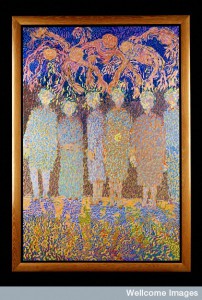
L0032442 CARSON: Patients waiting to see doctor
Credit: Carson, Rosemary/The Wellcome Library, London. Wellcome Images
images@wellcome.ac.uk
http://wellcomeimages.org
Patients waiting to see the doctor, with figures representing their fears.
Oil
4e/62/1997 By: Rosemary CarsonPublished: 1997.
Copyrighted work available under Creative Commons Attribution only licence CC BY 4.0 http://creativecommons.org/licenses/by/4.0/
This image stood out to me because of the first top half of the image. This image is a little different than what we’ve been looking at in class so far. This is an oil painting that at first glance the images look like demons or some kind of evil spirits. The artist painted them in red which is what stuck out to me. Upon reading the title, the image made perfect sense to me. It is titled “Patients waiting to see doctor”. These figures are suppose to represent their fears which is an awesome image to me. The people in the image aren’t clearly drawn. There are no facial features, on any of the humans, but you can see some features on the “fears” floating above.
I think people do feel like this when they go to the doctor, which is why many people don’t visit the doctor as frequently as they should. They fear what the outcome of the experience might be. I think this image is a perfect representation of how many people feel and the anxiety they experience .
homework #1
http://wellcomeimages.org/indexplus/email/292864.html
This painting captured my attention. The painting is called a vergers dream: Saint Cosmas and Damian performing a miraculous cure by transplantation of leg.This is an oil painting. The painter had used a variety of colors to make this painting vibrant. The green drapery looks elegant in the background. Since this is all a dream, the verger is sleeping peacefully. He is draped with white and red sheets. The two saints dressed in colorful robes stand on the side of the bed. There are golden circles at the back of their heads. One saint has a limb in his hand while the other saint is holding a circular yellow box, as if the tools needed for the transplant. There is an angel behind the saints who is praying. There are two more angels in the room, they are kneeling on the other side of the bed. All the angels have colorful wings. One angel is holding a candle in his hand and the other angel has the Verger’s limb that is being replaced from the knee. Presence of candle in the angel’s hand suggests that it is night time and also the title of the painting says that it is a dream. Since this a miracle, we do not see any blood in the scene. The saint who is performing the miracle is attaching a dark colored limb to the vergers body, probably from someone who is already dead. verger’s leg must be diseased.
Andrea Ibarra – Wellcome Image

V0017247 A birth-scene. Oil painting by a French (?) painter, Åbo, Sw
Credit: Wellcome Library, London. Wellcome Images
images@wellcome.ac.uk
http://wellcomeimages.org
A birth-scene. Oil painting by a French (?) painter, Åbo, Sweden (later Turku, Finland), 1800.
1800 Published: –
Copyrighted work available under Creative Commons Attribution only licence CC BY 4.0 http://creativecommons.org/licenses/by/4.0/
This image caught my attention immediately because I can appreciate a birth scene, not a typical one. In this modern world, you don’t see often a home birth. This image was published in 1800, in this time there was no medical equipment and medical care for this occasion. In this image you can see three people focus in the birth of a child. I can tell the man in the left is the doctor or the experienced midwife, and the old lady in the right is the mom who is very worried about her daughter and the grandchild on the way. The third person in this picture I believe is the sister who is more calmed and is helping the midwife. This image describes the essence of human life. Giving life is the most beautiful thing a human being has done. In the history of man, animal or any species known to man giving life is the most important accomplishment.
![L0021970 An operator extracting a tooth. Oil painting by an unidentif Credit: Wellcome Library, London. Wellcome Images images@wellcome.ac.uk http://wellcomeimages.org An operator extracting a tooth. Oil painting by an unidentified painter, 16--, after Theodor Rombouts. Paintings and other records from the 16th to the early 20th centuries capture performers in action. In the 17th century, travelling actors worked in troupes as a support act to specialist tooth-drawers who were themselves part of the act. These operators often had craft skills, experience, and expensive specialist instruments, like those shown on the table in this painting. Because they worked outside the guild system of locally established surgeons, the latter often tried to protect their own business by dubbing the interlopers as charlatans or quacks and taking them to court. However, the travelling dentists performed a useful service, were often brilliant entertainers, and were therefore a very popular and welcome presence at fairs and markets. In this painting, the leader of the troupe, near the centre, is a roving dental specialist, performing or pretending to perform a tooth extraction. He is surrounded by his companions who pretend to be casual bystanders. The composition was the invention of the short-lived Flemish painter Theodor Rombouts (1597-1637). He had worked in Italy where he learnt the technique (called Caravaggesque) of composing horizontal groupings of half-length figures in action, as here. Such paintings usually illustrate some illusion or deception: here the man in the right foreground is being gulled by all the other people, in an attempt to get him to volunteer to have a bad tooth extracted, or to buy a medicine to ease the pain. Oil 1600-1699 By: Theodoor RomboutsPublished: [16--] Copyrighted work available under Creative Commons Attribution only licence CC BY 4.0 http://creativecommons.org/licenses/by/4.0/](https://openlab.citytech.cuny.edu/arth2101fa2015/files/2015/09/tooth-pulled-300x181.jpg)
L0021970 An operator extracting a tooth. Oil painting by an unidentif
Credit: Wellcome Library, London. Wellcome Images
images@wellcome.ac.uk
http://wellcomeimages.org
An operator extracting a tooth. Oil painting by an unidentified painter, 16–, after Theodor Rombouts.
Paintings and other records from the 16th to the early 20th centuries capture performers in action. In the 17th century, travelling actors worked in troupes as a support act to specialist tooth-drawers who were themselves part of the act. These operators often had craft skills, experience, and expensive specialist instruments, like those shown on the table in this painting. Because they worked outside the guild system of locally established surgeons, the latter often tried to protect their own business by dubbing the interlopers as charlatans or quacks and taking them to court. However, the travelling dentists performed a useful service, were often brilliant entertainers, and were therefore a very popular and welcome presence at fairs and markets.
In this painting, the leader of the troupe, near the centre, is a roving dental specialist, performing or pretending to perform a tooth extraction. He is surrounded by his companions who pretend to be casual bystanders. The composition was the invention of the short-lived Flemish painter Theodor Rombouts (1597-1637). He had worked in Italy where he learnt the technique (called Caravaggesque) of composing horizontal groupings of half-length figures in action, as here. Such paintings usually illustrate some illusion or deception: here the man in the right foreground is being gulled by all the other people, in an attempt to get him to volunteer to have a bad tooth extracted, or to buy a medicine to ease the pain.
Oil
1600-1699 By: Theodoor RomboutsPublished: [16–]
Copyrighted work available under Creative Commons Attribution only licence CC BY 4.0 http://creativecommons.org/licenses/by/4.0/
Wellcome Home Work
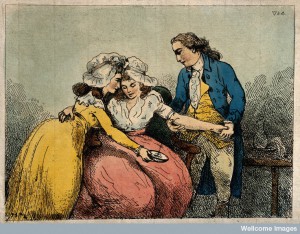
V0016791 A surgeon bleeding the arm of a young woman: she is being co
Credit: Wellcome Library, London. Wellcome Images
images@wellcome.ac.uk
http://wellcomeimages.org
A surgeon bleeding the arm of a young woman: she is being comforted by another woman. Coloured etching by T. Rowlandson (?), 1784.
1784 By: Thomas RowlandsonPublished: –
Copyrighted work available under Creative Commons Attribution only licence CC BY 4.0 http://creativecommons.org/licenses/by/4.0/
The Wellcome image I chose was from 1784. It is an engraving by Thomas Rowlandson and it depicts a young woman being bled by a doctor. There are three figures in the image. Two are female and one is male. The central figure is female and is interacting with both other figured. The make figure is to the central figured right and is holding the central figures arm. The figure on the left is also female and is embracing the central figure and holding a bowl in the cereal figured lap that is collecting blood.
The make figure is presumably the doctor. He wears a blue coat, yellow vest and white pants and shirt. The central figure wears a pink dress and the left figure wears a yellow dress. There are only nine distinct colors in the image. The colors are black, yellow, pink, white, blue, gray, beige brown and white. All the figures gave the same shade of hair and skin. The yellow of the dress and the best ate identical. Although the image portrays a woman being bled, there is no red. The blood is represented by black lines falling neatly from the central figures arm into the bowl. The entire scene is very calm and civilized, there is no mess. It portrays blood letting as a simple , relatively painless procedure, reflecting the attitude of the time.

